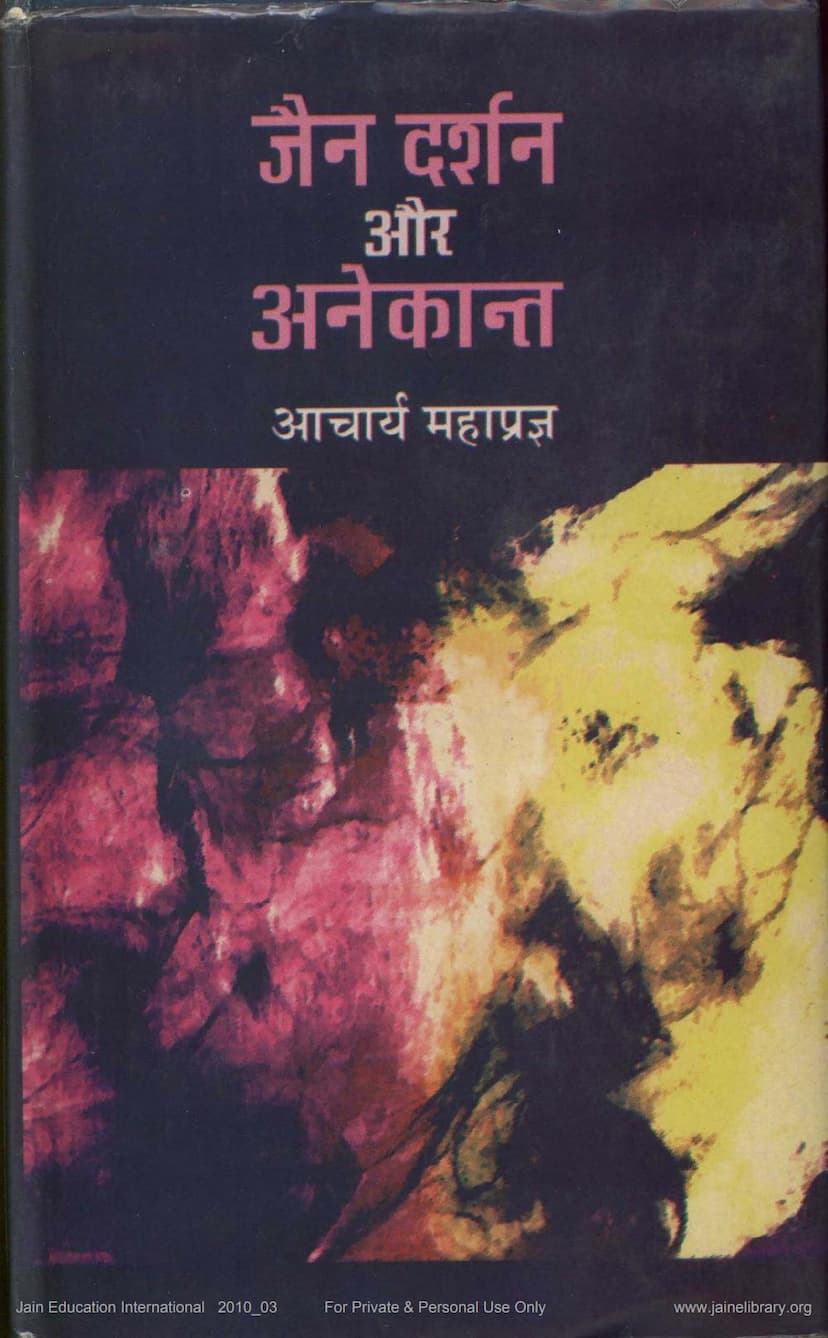Jain Darshan Aur Anekanta
Added to library: September 1, 2025

Summary
This is a comprehensive summary of "Jain Darshan aur Anekanta" by Acharya Mahaprajna, based on the provided text:
Book Title: Jain Darshan aur Anekanta (Jain Philosophy and Non-Absolutism) Author: Acharya Mahaprajna Publisher: Adarsh Sahitya Sangh Key Theme: The book explores the fundamental Jain principle of Anekanta (non-absolutism or multi-faceted reality) and its application in understanding Jain philosophy.
Core Argument and Philosophy:
The central thesis of the book is that Anekanta is the interpretative key to Jain philosophy. Acharya Mahaprajna argues that to understand Jainism, one must grasp Anekanta. He asserts that contradiction is a universal law of existence. Everything that exists is characterized by the co-existence of opposing pairs. Anekanta, in its essence, is a principle of "friendship" or harmony between these opposing forces within existence. It provides a language and definition for the co-existence of dualities and discovers the threads of coordination within them.
Key Concepts and Chapters Discussed (as indicated by the table of contents):
The book is divided into two main sections: "Anekanta" and "Jain Darshan." Within these sections, a wide range of philosophical concepts are explored, demonstrating how Anekanta underpins them:
Section 1: Anekanta (Non-Absolutism)
- Dvaitvad (Dualism): This section delves into the dualistic nature of reality, discussing the interplay of relative and absolute truth. It highlights the Jain understanding that existence is characterized by dualistic pairs (e.g., consciousness and unconsciousness, dependent and independent existence).
- Syadvada and Jagat (Syadvada and the Universe): Syadvada, the doctrine of conditional predication, is presented as the explanatory method for understanding the Anekantic nature of the universe. It explains how seemingly contradictory statements can all be true from different perspectives.
- Vichar ki Aadharbhitti: Nayavad Sadvaad (The Foundation of Thought: Nayavada and Sadvaad): This explores the role of Naya (standpoints or perspectives) and Sadvada (the doctrine of truth from multiple perspectives) as the bedrock of Jain logic and thought.
- Syadvada: A detailed examination of Syadvada, the doctrine that propounds that all statements are conditional and relative.
- Atmavaad (Soul-ism): The concept of the soul as a fundamental reality, exploring its nature and various aspects.
- Karya-Karanvaad (Causality): An examination of cause and effect, likely through the lens of Anekanta, suggesting that causality itself can be understood from multiple perspectives.
- Ishwarvad: Karmavaad (Theism: Karma-ism): Discusses the Jain perspective on God and karma, likely contrasting it with other philosophical systems and emphasizing the role of karma as a natural law rather than divine intervention.
- Niyamvaad (Principle-ism / Rule-ism): The idea that existence is governed by underlying principles or laws.
- Nirvaanvaad (Nirvana-ism): The Jain concept of liberation or enlightenment, achieved through understanding and practicing Anekanta.
- Punarjanmavaad (Rebirth-ism): The doctrine of reincarnation and transmigration, understood within the framework of Anekanta.
- Anekantavaad (Non-Absolutism): A comprehensive discussion of the core principle itself.
- Naitikta ki Dharana (Concept of Morality): How Anekanta informs ethical principles and conduct.
Section 2: Jain Darshan (Jain Philosophy)
This section delves into the various philosophical tenets of Jainism, demonstrating their interconnectedness and grounding in Anekanta.
Key Takeaways and Elaborations from the Text:
- Co-existence of Opposites: The book repeatedly emphasizes that all existence is characterized by the simultaneous presence of opposing pairs (e.g., eternal and changing, existent and non-existent, general and specific). Anekanta explains how these opposites are not mutually exclusive but rather complementary aspects of reality.
- Rejection of Absolutism: Anekanta critiques any philosophy that claims to possess the sole, absolute truth. It posits that reality is too complex to be captured by a single, one-sided perspective.
- Naya and Syadvada as Tools: The concepts of Naya (standpoints) and Syadvada (conditional predication) are presented as the methodological tools of Anekanta. By adopting different standpoints (Nayas) and using conditional language (Syadvada), one can apprehend the multifaceted nature of reality without falling into dogmatism.
- The Soul (Jiva) and Matter (Pudgala): The book explores the Jain understanding of the soul and matter, emphasizing their distinct yet interacting natures, analyzed through the lens of Anekanta. The concept of the soul having "countless regions" (asamkhya pradeshatmak) is highlighted.
- Dravya, Guna, and Paryaya: The Jain ontological framework of substance (dravya), qualities (guna), and modes (paryaya) is discussed, showing how Anekanta applies to understanding the relationship between the permanent substance and its transient manifestations.
- Scientific Parallels: The author draws parallels between Anekanta principles and modern scientific concepts like quantum physics, the existence of anti-particles, and the wave-particle duality of light, suggesting the timeless relevance of Jain philosophy.
- "Sayat" (Perhaps/Maybe): The crucial role of the word "Syat" in Syadvada is explained as indicating relativity and conditionality, acknowledging that each statement is true only from a particular perspective.
- The Interdependence of Concepts: The book shows how core Jain concepts like Anekanta, Syadvada, Naya, Karma, Soul, and Liberation are all interconnected and understood through the comprehensive principle of Anekanta.
- Practical Application: The ultimate goal is to achieve a clearer vision of reality, leading to a deeper understanding of Jain philosophy and a more harmonious way of living.
Overall Message:
"Jain Darshan aur Anekanta" serves as a profound exposition of Anekanta, presenting it not just as a philosophical doctrine but as a comprehensive worldview that embraces complexity, avoids dogmatism, and fosters understanding and reconciliation of apparent contradictions in existence. It invites readers to adopt a multi-dimensional perspective to grasp the true nature of reality.